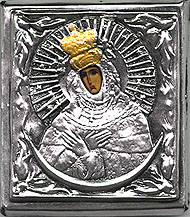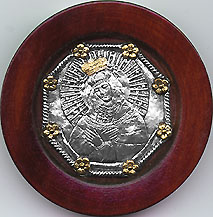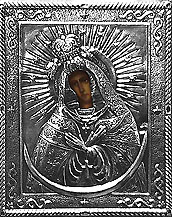Vilnius is the present day capitol of Lithuania. Part of the history of the area is that Vilnius (and Lithuania) were joined with Poland. One indication or result of this union is that Vilnius (Wilno in Polish) is unmistakably Catholic - and Polish - in feel and atmosphere, a jumbled mix of cobbled alleyways, high spires, Catholic shrines , cerkwi (Orthodox, Uniate churches) and old Jewish monuments.*
The Virgin of Vilnius icon is enshrined in this capitol city of Lithuania. The icon, also known as "Our Load of Ostra Brama", provides a focal point for Byzantine (Eastern) Catholics, Roman Catholics, and Orthodox. The original Ostra Brama icon can be seen from the street below in its chapel housing at the Ostra Brama gate. In WWII, Byzantine Catholics concealed Jews at the Ostra Brama location but were executed for their efforts (a similar fate occurring in WWII Poland under Nazi domination). Roman Catholic monks were more successful in hiding Jews and even set up a synagogue behind the icon.
There are several aspects of the Virgin of Vilnius icon worth noting. Perhaps the most unusual aspect is the crossed hands. In similar icons where She is pictured alone not holding Child Jesus, the Virgin's position is more typically in orans (in the attitude of prayer, with arms and hands extended upward or extending towards Christ).
Another unusual aspect of this icon is the relatively large robe and veil. Since early Byzantine times, the Virgin has been pictured covered by a flowing floor length robe with a veil showing her hands, face, neck, and sometimes mall part of one ear. In the Ostra Brama icon, though the robe is unusually large. The crescent shape at the bottom of the icon is unique and represents a sash securing the Virgin's robe.
The presence of a crown, indicating the Virgin as Queen of Heaven, was not an iconographic form originating from St. Luke, progenitor of Christian icon painting. Instead, the crown on the Virgin came into being only after the Nicaean council, in approving the Nicene Creed in 325 AD, elevated the status of Mary of the Mother of God (in contrast to being Mother of Jesus) at the same time elevating women within the ranks of the Church hierarchy. In very early Christian times, neither the Virgin nor Christ is portrayed with a crown.
Finally, the radiating lines in the background are an iconographic element from the last few hundred years (e.g., this stylistic element is unknown in Byzantine iconography)., The radiating line have various interpretations relating to the glory of God in this universe.
* From "Poland the Rough Guide", Mark Salter & Gordon McLachlan, New York; Penguin Books, 1993.
Please also see separate page on the historical Ostra Brama icon.





